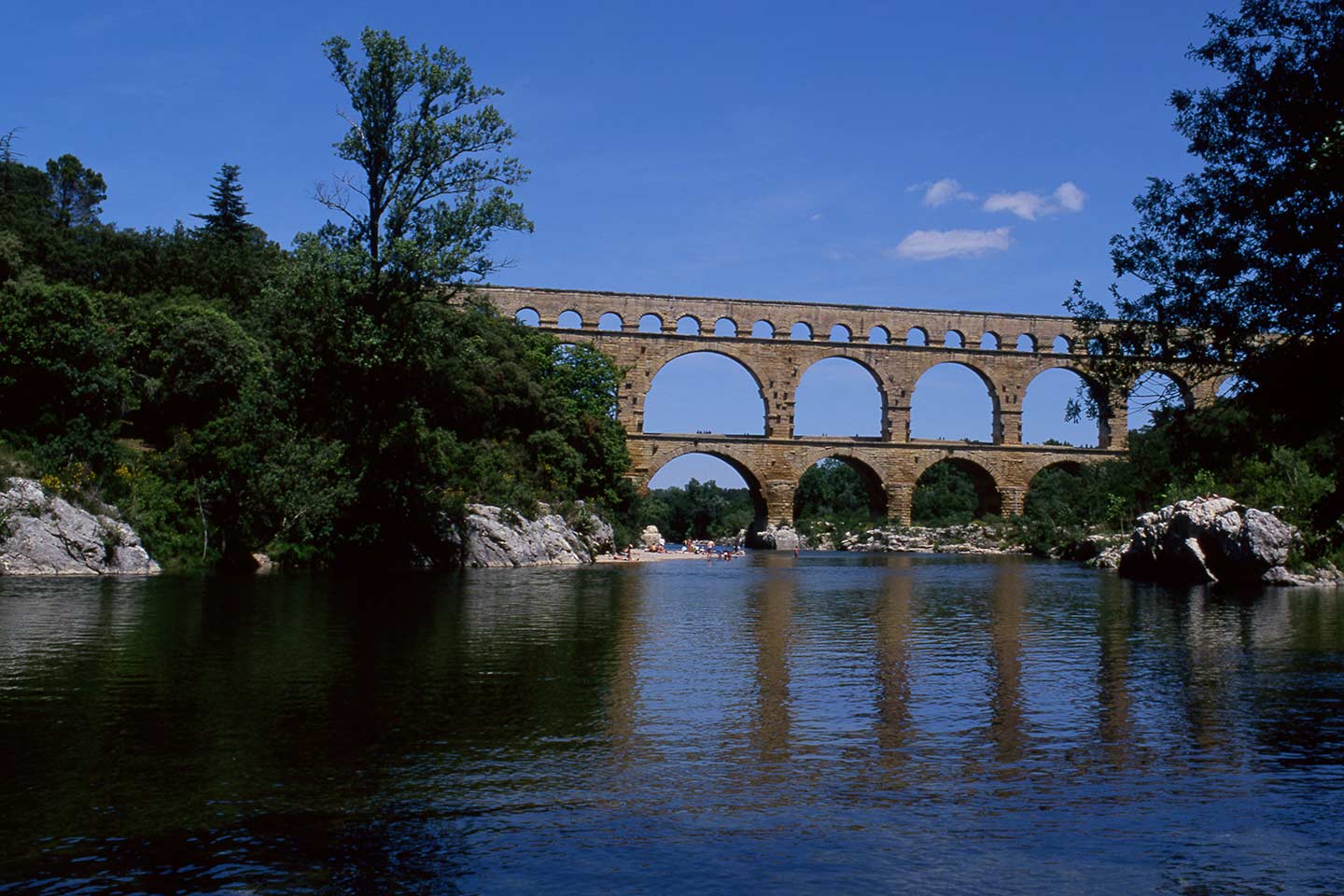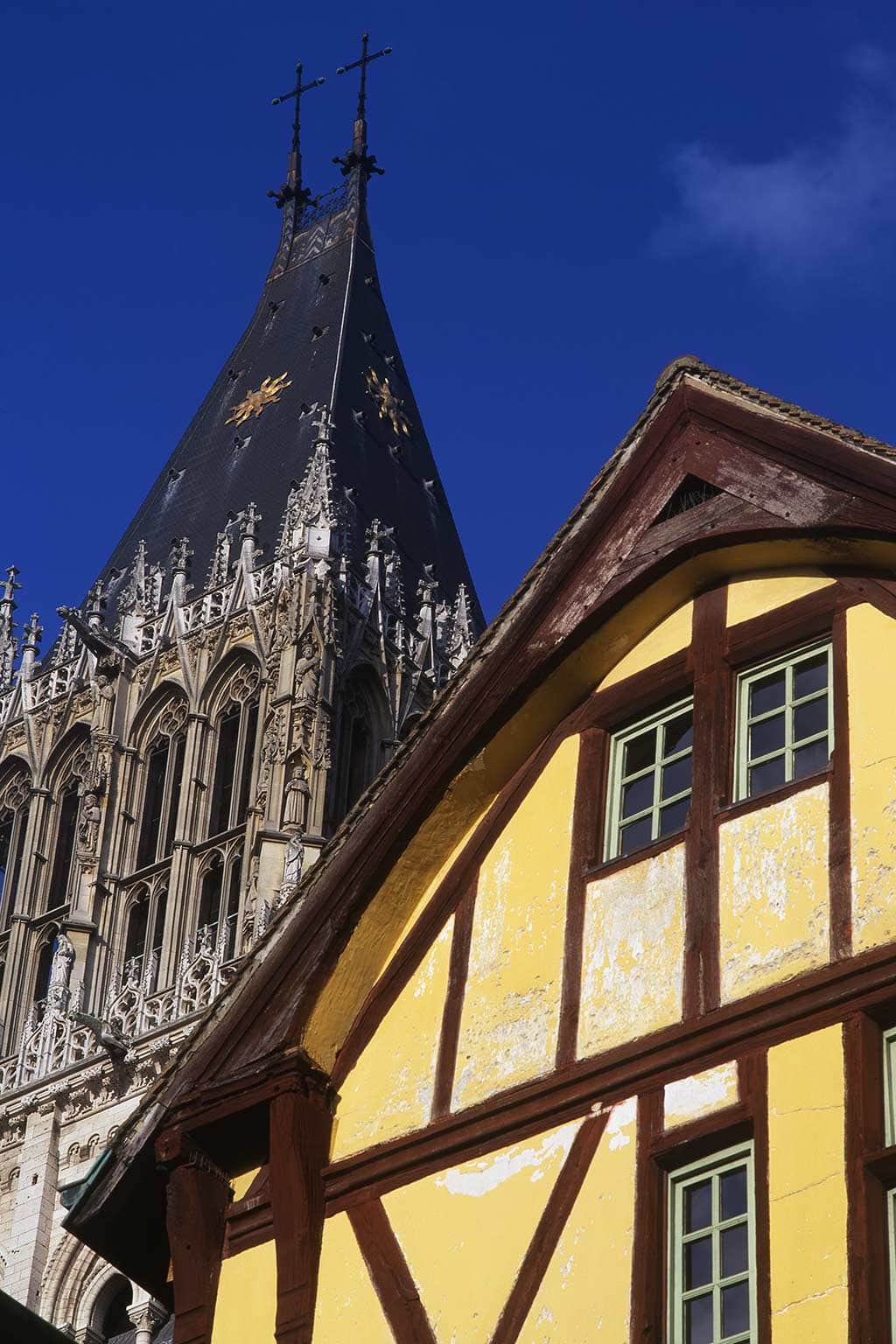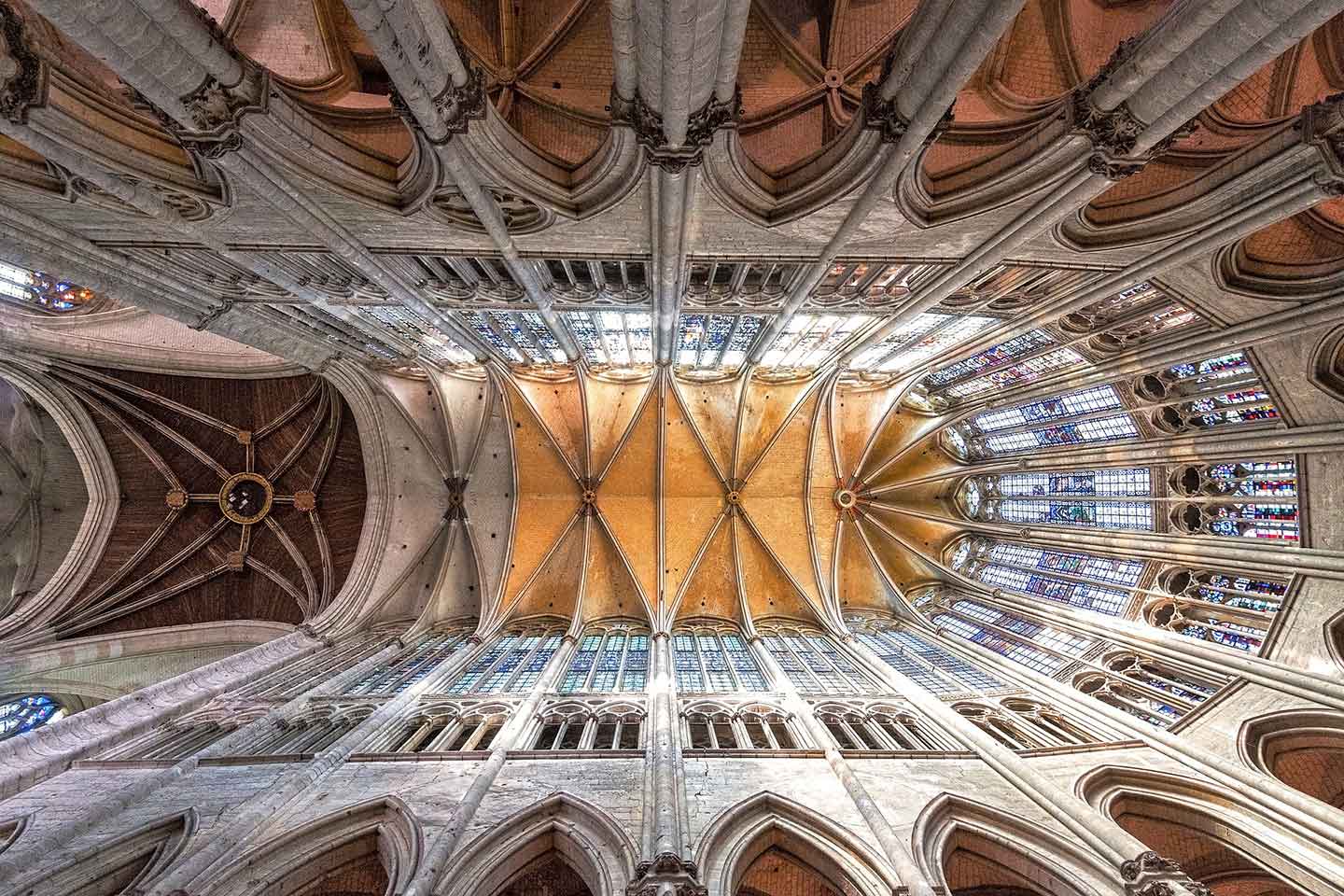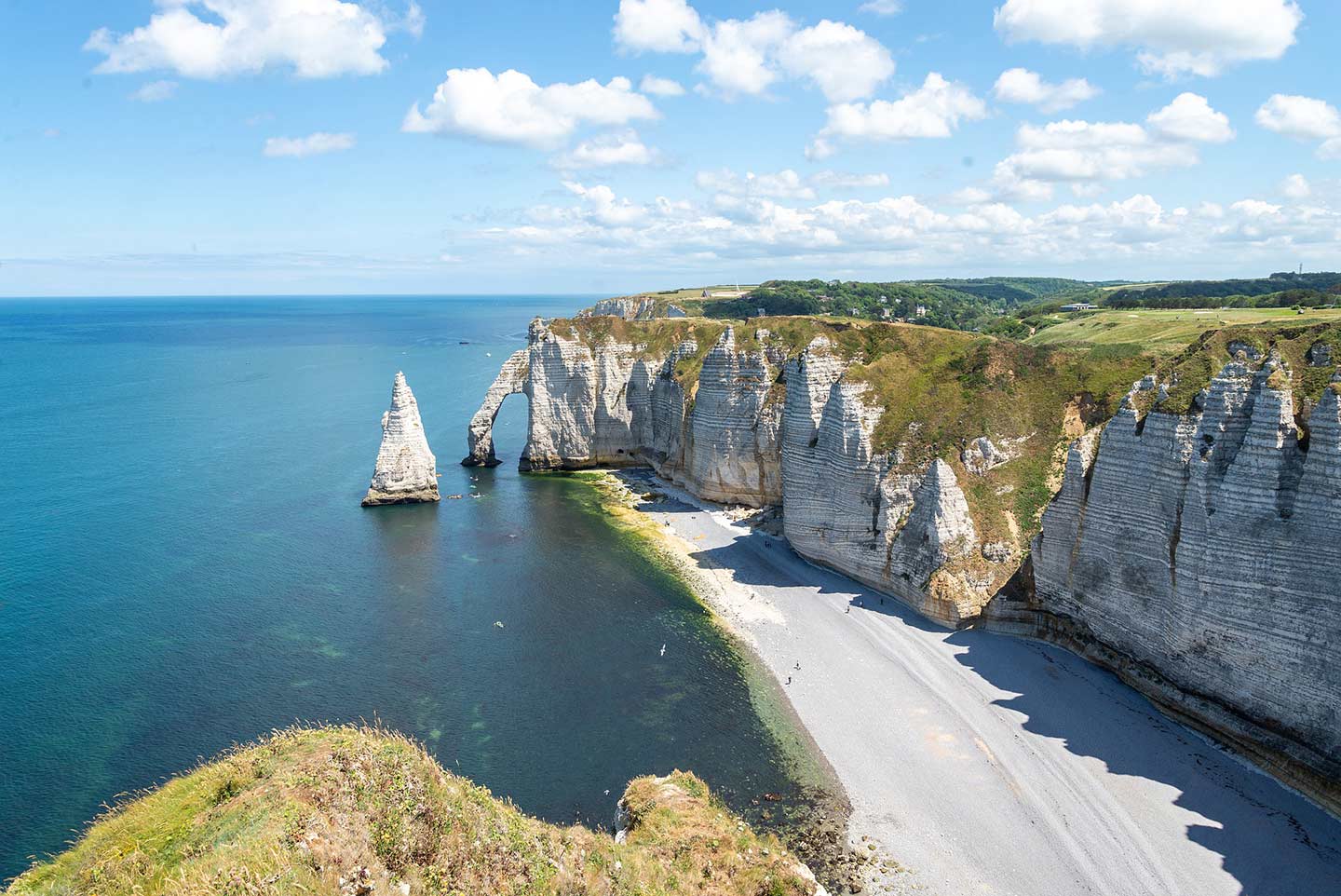It’s the most-visited country in the world, so it’s not entirely surprising that there’s a vast wealth of famous landmarks in France to explore.
Join us as we embark on a virtual journey around over 30 of the best landmarks of France, which will hopefully whet your appetite for further discoveries in this extraordinary country.
Some of the landmarks in France that we’ve included are more famous than others. The Eiffel Tower and Arc de Triomphe are universally recognised. If you didn’t know Notre Dame Cathedral before 2019, you almost certainly do now, after the tragic fire that engulfed much of its roof.
We’ve devoted most of this article to French landmarks outside the capital. Within a 100-mile radius of Paris you’ll find six of the greatest Gothic cathedrals in Europe (and the world).
Venture further and you’ll find some of the wonders of the Normandy coastline including Le Mont St Michel, or the chateaux of the Loire Valley. Further south you’ll discover Roman temples and arenas, fortified hilltop villages and endless sweeps of lavender fields across the Provence landscape. We’ve been fortunate to have visited them all – some many times over.
It’s a wonderful journey – we hope you enjoy it as much as us.
Famous Landmarks In France
1. Eiffel Tower

Not merely a landmark, but the symbol of Paris, and France
La Tour Eiffel is the best-known of the landmarks of Paris, an unmistakable shape and silhouette that is shorthand for ‘France’ the world over. It’s one of a select number of European landmarks – like Big Ben or the Leaning Tower of Pisa – that almost transcend fame. Everyone knows what and where it is.

And climbing it is a rite of passage if you visit Paris – there are three etages, or stages, where you can stop. The third stage is almost 900 feet high, and the other great Paris landmarks seem awfully small from up there.
The Eiffel Tower is also very close to the Statue of Liberty in Paris, a famous replica of the New York landmark (and one of several replicas across the city) that was created in Paris.
See Also: The 28 Best Eiffel Tower Views In Paris
2. Pont du Gard

What DID the Romans do for us…?
One of the most recognisable French landmarks with its three rows of arches, the Pont du Gard is a Roman aqueduct built to supply water to the nearby town of Nemausus, now Nimes.
It spans the Gardon river, dates from the 1st century AD and remained in use for 500 years, until its channels clogged up. One of the easiest day trips from Avignon or Nimes, it’s one of the most remarkable places to visit in France.
See Also: 21 Most Beautiful Bridges In Europe
3. Notre Dame de Paris



Gothic masterpiece awaiting restoration after severe fire damage
Notre Dame Cathedral is one of the greatest landmarks of France, and one of the finest Gothic buildings to survive the Middle Ages. Most of the great French cathedrals are dedicated to Notre Dame – Our Lady – but when anyone says,’Notre Dame’, it’s Notre Dame de Paris they mean.
It was immortalised in Victor Hugo’s novel Notre Dame de Paris (usually titled The Hunchback of Notre Dame in English). The Cathedral suffered a catastrophic fire which destroyed its spire and much of its roof in April 2019. It’ll be some years before we see it in all its glory again, but most of its artworks were saved by Cathedral staff.
4. Millau Viaduct


The highest bridge in Europe
The tallest, and one of the most impressive bridges in Europe, Norman Foster’s Viaduc de Millau carries the A75 autoroute (motorway) that links Paris and Montpellier across the deep Tarn valley a few miles from the town of Millau.
It’s a very graceful structure, supported by white piers of differing height, and the road stands up to 270 metres above the valley floor.
There are designated viewpoints, including one just to the north of the Viaduct – take the exit 1 km before the bridge. Also take a look at the lovely village of Peyre, just below the Viaduct.
5. Louvre Museum

A great Paris landmark without, one of the great museums of the world lies within
When I first visited the Louvre in the 1980s, this extraordinary museum was better known for the exhibits within, rather than the admittedly magnificent Palace in which it is housed. That changed with the expansion of the Museum to include the entire Louvre Palace, and the addition of I M Pei’s superb glass pyramid, leading to an underground entrance.
It works beautifully in conjunction with the late medieval Palace behind. It’s best known as the home of Leonardo da Vinci’s Mona Lisa but there’s enough to see to keep you there for days.
6. Rouen Cathedral


The muse of Monet
The west front of Rouen Cathedral was one of the favourite subjects of the Impressionist master, who lived a short distance up the Seine valley at Giverny. He painted it over 30 times to study the effect of light on the Cathedral’s west façade at different times of day and year. This famous French landmark is best-known for its west front, but it’s also a Gothic masterpiece, with the later addition of the tallest church spire in France, at 495 feet in height.
See Also: 12 Wonderful Things To Do In Rouen
7. Arc de Triomphe

Possibly the most famous – and busiest – traffic roundabout in the world
Stand outside the Louvre, looking at the handsome Arc de Triomphe du Carrousel at the entrance to the Tuileries Gardens.
In the distance you’ll see its more famous cousin, the Arc de Triomphe de l’Etoile, at the top of the Avenue des Champs-Elysees.


The Arc de Triomphe Paris, one of the most familiar landmarks in Paris, is the focal point of the city’s Axe Historique (Historic Axis).
It was built to honour the French soldiers who died in the Revolutionary and Napoleonic Wars, and was completed in 1836. The Tomb of the Unknown Soldier, who died during World War I, is beneath the arch.
8. Hotel Negresco Nice

One of the most famous luxury hotels in France
The Negresco Hotel, on the Promenade des Anglais overlooking the Mediterranean, is one of the finest luxury hotels in Europe.
It has been welcoming guests since 1913, though many of the furnishings and artwork date back to the 17th and 18th centuries.
Tastefully opulent, Le Negresco is also home to the world-renowned Le Chantecler Restaurant.
9. Chateau de Versailles

Enormous palace complex on outskirts of Paris
The vast Palace of Versailles was built by the Sun King, Louis XIV, in the 17th century, and he relocated his entire court and retinue there from Paris. As well as the main palace, the complex also includes the Grand Trianon and Petit Trianon Palaces, and the Hameau (Hamlet) of Queen Marie Antoinette.
The most famous room in the Palace is the Hall of Mirrors (Galerie des Glaces), where the 1919 Treaty of Versailles- which formally ended World War I (and, some would argue, sowed the seeds of World War II) was signed.
10. Carcassonne Cité

Not just a fairytale castle – but a whole citadel
One of the most intriguing French famous landmarks, the cité de Carcassonne is a hugely impressive fortified city in south-west France. By the 13th century it was an important fortress on the border between France and the Crown of Aragon (part of modern Spain), and it withstood English attacks during the Hundred Years War with England.
Its importance diminished as France acquired land as far south as the Pyrenees. Facing demolition in the 19th century, funds were raised to restore it under the guidance of Eugene Viollet-le-Duc.
11. Sacré Coeur Basilica, Paris

Landmark church with a bird’s eye view of Paris
The Basilica of Sacré Coeur (Sacred Heart of Jesus) is one of the most prominent and famous landmarks in Paris, occupying an excellent vantage point at the summit of the Butte de Montmartre hill which overlooks the city.

It was built between 1875 and 1914 to the design of Paul Abadie. It’s almost Byzantine in style with its domes and arches, though its exterior in white travertine stone is fairly simple. The classic view of Sacré Coeur is from the foot of the hill below.
See Also: Visiting Sacré Coeur Basilica Paris
12. Roussillon Village, Provence


An oasis of ochre in a desert of green
The village of Roussillon is remarkable for its ochre colouring and quarries, which are surrounded by green Provencal countryside. It’s one of the most beautiful villages in France, with some stunning colourful houses, not all of which are ochre.
A pathway from the village, the Sentier des Ocres, leads through some of the local quarries. The rich colour is reminiscent of some of the great American canyons in Utah and Arizona. The village also offers great views of nearby Mont Ventoux.
See Also: 15 Of The Most Beautiful Villages In Europe
13. Abbesses Metro Station Entrance, Paris

Iconic station entrance like the wing of a butterfly
Possibly the smallest French landmark on our list, the ‘dragonfly’ entrance to Abbesses Metro station is the most exquisite.
This gorgeous Art Nouveau entrance, or edicule, was designed by Hector Guimard, with a wrought iron and glass roof and the distinctive ‘Metropolitain’ sign in Art Nouveau-style lettering.
It’s on line 12, near the foot of Montmartre hill, a short walk from two other famous Parisian landmarks, Sacre Coeur and the Moulin Rouge.
14. Quai Ste Catherine, Honfleur Harbour, Normandy


One of the most beautiful harbours – and streets – in France
The Vieux Bassin is the oldest part of the port of Honfleur, which is on the opposite side of the mouth of the river Seine from the much larger port of Le Havre.
The northern side of the Bassin is Quai Ste Catherine, a handsome row of tall slate-fronted townhouses that has been a draw for artists (including Monet) and tourists for well over a century. It’s named after the impressive wooden church of Ste Catherine nearby.
15. Beauvais Cathedral

Unfinished Gothic masterpiece with the highest Gothic vault in the world
Medieval bishops were a competitive lot, often trying to outdo one another with their vast cathedrals. Beauvais, an hour north of Paris, aimed for the sky, building the highest Gothic vault – and indeed the highest nave roof – on the planet. Collapsed buttresses and a central tower, not to mention the Hundred Years War, meant that the original plans were never fulfilled.
The result is a patch-up job with a truncated nave. Even when you stand at the back of the Cathedral, your eyes can’t quite take in the whole scene from the floor to the apex of the 157 foot (47 metre) vault – I had to tilt my head on its side to see it all at once. Perhaps not one of the most famous French landmarks, but surely one of the most remarkable.
16. Maison Carrée, Nimes

Beautifully preserved Roman temple in the heart of Nimes
The Maison Carrée is one of the finest ancient monuments in France. Its most memorable feature is its portico, with six Corinthian pillars, one of the best of its kind to have survived. It used to house the Musee des Beaux Arts de Nimes, but now stands empty, as it did in ancient times.
The ancient temple contrasts with the modern Carré d’Art museum across the street, designed by Norman Foster. It’s a short walk away from the other main Nimes attraction, the Arènes, or Amphitheatre.
17. Étretat Chalk Cliffs

The highlight of Normandy’s Côte d’Albâtre
The Falaises d’ Étretat are famous white chalk cliffs and natural rock formations either side of the small Norman seaside town of Étretat, north of the port of Le Havre on the scenic Alabaster Coast.
It is among the most famous places to visit in Normandy, with a superb white sand beach as well as the cliffs to admire. The best-known cliff is the Falaise d’Aval, just to the south-west of the town, with its famous sea arch which resembles an elephant’s trunk being dipped in the water.
18. Arles Amphitheatre


One of the greatest Roman arenas – still in use 2,000 years on
Les Arenes d’Arles was built in the 1st century AD, not long after its inspiration, the Colosseum in Rome. It’s smaller than the great Roman arena but arguably in better condition – it’s still used for events including (no-kill) bullfights and summer concerts. The towers are a medieval addition, built to help turn the amphitheatre into a fortress.
Climb the steps for an unrivalled view of the rooftops of this fine old city and the river Rhône. One of the greatest Roman monuments in Europe.
19. Chartres Cathedral

One of the greatest buildings of the Middle Ages
One of the greatest landmarks France has is Notre Dame de Chartres, the astonishing Gothic cathedral in the city of Chartres, 50 miles (80 km) south-west of Paris in the Ile-de-France region. Much of it dates from the 13th century – one of the west towers was added later – but it is possibly the pinnacle of European Gothic architecture. I
t was built to house the Sancta Camisia relic – a veil believed to have been worn by the Virgin Mary during the birth of Christ. The Cathedral is perhaps best-known for its incredible array of medieval stained glass.
20. Gordes

Picture-perfect Provencal village
Gordes is one of the most beautiful villages in Provence and, indeed, France. The best view of it is from the approach road, the centuries-old stone buildings hugging the steep sides of the hill. It has long been an inspiration for artists, and there’s a museum featuring the work of Pol Mara within the chateau.
The village is a warren of back streets and alleyways, and the best thing to do there is just wander. While in the area, also check out the nearby Village des Bories (stone hive-shaped huts) and the chateau at Lacoste.
21. Le Mont St Michel

Abbey said to be inspired by three visions of the Archangel Michael
Le Mont St Michel – the Mount of St Michael – is among the best-known monuments of France, and most beautiful islands in Europe. It’s a tiny granite tidal island next to the estuary of the Couesnon, the ancient boundary between the duchies of Normandy and Brittany.
It’s named after St Michael the Archangel, who is said to have appeared to a local bishop three times urging him to build a monastery at this precarious location. The monastery – one of the finest churches in France – was indeed built, as was the picturesque (but now heavily touristed) village below, and fortifications around the shore. One of the greatest landmarks in Europe.
22. Albi Cathedral


What is it – a church or a castle?
The bulky brick Cathedrale Ste Cecile soars high above the rooftops of Albi, and its vast form, thick walls and narrow windows give it the appearance of a forbidding fortress rather than a Cathedral.
One of the most underrated landmarks of France, it was meant to intimidate, demonstrating the might of the Church against heretics such as the Albigensians, or Cathars, who were persecuted for their different views to Rome.
The interior couldn’t contrast more with it, a lavishly decorated church that became a UNESCO World Heritage Site in 2010.
23. Chateau de Chambord

Does one building really need 282 fireplaces?
The Loire Valley chateaux are among the most famous buildings in France, so we’ve gone with the biggest of the lot, Chambord Chateau, a few kilometres east of the lovely little city of Blois. It was built by King Francois I as a hunting lodge – with a mere 440 rooms – while he continued to reside a few miles away at the chateau in Blois and also at nearby Amboise.
It’s a phenomenal building in the French Renaissance style, which was never quite finished. Its roofscape is particularly striking, its turrets, and cupolas resembling the skyline of a great medieval city.
24. Provence Lavender Fields

The most famous seasonal landmarks in France
The lavender fields of Provence cover huge swathes of the southern French landscape each year, turning the countryside into countless symmetrical rows of fragrant purple.
The most famous lavender field in Provence is one outside the Abbaye de Senanque, and you’ll also find fields close to the towns of Banon, Sault and Aurel, and eastwards around the towns of Manosque and Valensole. The only way to see them is to drive yourself or join a lavender fields tour.
25. Dune of Pilat, Arcachon

The tallest sand dune in Europe
The Grande Dune du Pilat is the highest sand dune on the continent, 110 metres high yet one of the toughest of France’s landmarks to climb. It’s the focal point of a surprisingly small dune system, a few kilometres to the south of Arcachon – it’s 2.7 km long and around 500 metres wide.
It’s well worth the tough climb for the view of the endless beaches on the Bay of Biscay and, inland, the forests of Les Landes.
26. St Michel d’Aiguilhe Chapel , Le Puy en Velay
If Mont St Michel is an unusual place to build a church, wait until you see this
The Auvergne city of Le Puy en Velay is best known for its lentils and as one of the main starting points for the Camino de Santiago pilgrimage route. It’s also home to one of the most improbable buildings in France, the gorgeous 10th century church of St Michel d’Aiguilhe (which translates as ‘St Michael of The Needle’).
Even if it was at ground level it would be one of the loveliest early medieval churches in France. However, it happens to be built on an almost sheer outcrop of volcanic rock, so it’s a 268-step schlep to the summit.
27. Mont Ventoux

The highest point in Provence and a famous port of call for the Tour de France
The barren Mont Ventoux – Windy Mountain – is one of the most famous places in France. It’s the highest summit in Provence proper, 1,909 metres (6,263 feet) above sea level, and it’s visible throughout much of the region. The drive to the summit rewards you with an extraordinary panorama over southern France, but if the mistral is blowing, the mountain lives up to its name. Spare a thought for the riders who have to pedal their way to the summit during the Tour de France.
28. Mont Blanc

The highest point in western Europe
Mont Blanc – ‘White Mountain’ in English – is the highest mountain in Western Europe, at 4,808 metres (15,774 feet). It is only surpassed in all of Europe by Mount Elbrus in southern Russia.
Climbing it is a two-day undertaking via the popular Gouter Route – allow at least the same for the descent. The summit is on the French-Italian border, with both countries having long-standing claims over it. One of the most famous places of France, and one of the most spectacular.
29. Pont d’Avignon


Inspired the song ‘Sur le pont d’Avignon’
The city of Avignon is home to two famous French landmarks – the imposing, indeed forbidding, Palais des Papes and the four arches of the Pont St Benezet which reach out forlornly into the river Rhône, never to reach the opposite bank. At one time the bridge did successfully span this famous French river, but most of the arches weren’t able to withstand its floods.
The Chapel of St Nicholas on the bridge housed the relics of the 12th century St Benezet, who instigated the building of the bridge after a vision. They are now housed in the church of St Didier in Avignon.
See Also: One Day In Avignon – 24 Hours In The City Of Popes
30. Les Baux de Provence


Dramatically sited village in the Alpilles hills
One of a cluster of famous France landmarks in this corner of Provence (it’s very close to Arles and Avignon), Les Baux de Provence enjoys one of the most impressive settings of any villages in Provence.
The village and medieval castle were built on a rocky hill that is part of the Alpilles range, and command great views over the olive groves and coastal plain below. Apart from the castle, the village has several art galleries, two medieval churches and some delightful corners and alleyways.
31. Bonifacio Cliffs, Corsica

At its southernmost tip, Bonifacio is one of the best places to visit in Corsica, one of the most beautiful islands in Europe. The old town is perched on a narrow peninsula with a marina on one side and dramatic white limestone and granite cliffs on the seaward side.
Houses are huddled together along the clifftop, while rock-cut paths, including the Escalier du Roi d’Aragon, lead you on a further adventure along the cliff faces and down to the shoreline. The fantastic coastal scenery continues to the nearby Capo Pertusato headland and beyond.
32. Place Stanislas, Nancy

Place Stanislas is one of the finest squares in Europe, built by the former King of Poland Stanislaw Leszczynski after his accession as Duke of Lorraine in 1752 to link the old and new parts of the eastern city of Nancy. It’s a remarkable ensemble of buildings, including the Hotel de Ville (City Hall), Grand Hotel, Opera House and Museum.
Two corners of the square are decorated with elaborate golden gates, and there is also a fine triumphal arch, the Arc here. One of the most famous monuments in France, Europe hadn’t seen anything quite like it. It’s now a UNESCO World Heritage Site.

David Angel is a British photographer, writer and historian. He is a European travel expert with over 30 years’ experience exploring Europe. He has a degree in History from Manchester University, and his work is regularly featured in global media including the BBC, Condé Nast Traveler, The Guardian, The Times, and The Sunday Times. David is fluent in French and Welsh, and can also converse in Italian, German, Portuguese, Spanish, Czech and Polish.
You can read more of my articles on famous landmarks in Europe below:
- Famous landmarks in Venice
- Famous UK landmarks
- Famous Spanish landmarks
- Famous Landmarks in England
- Famous landmarks in Italy
- Famous landmarks in Austria
- Famous landmarks in Poland
- Famous landmarks in Prague
- Famous landmarks in Ireland
- Famous landmarks in Greece
- Famous landmarks in Berlin
- Famous London landmarks
- Famous landmarks in Portugal


